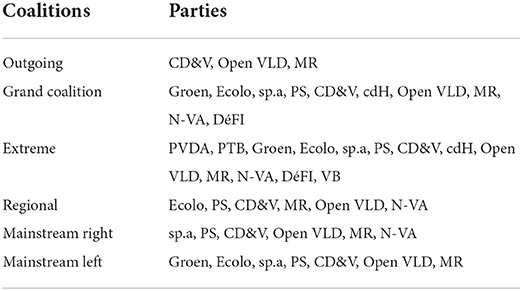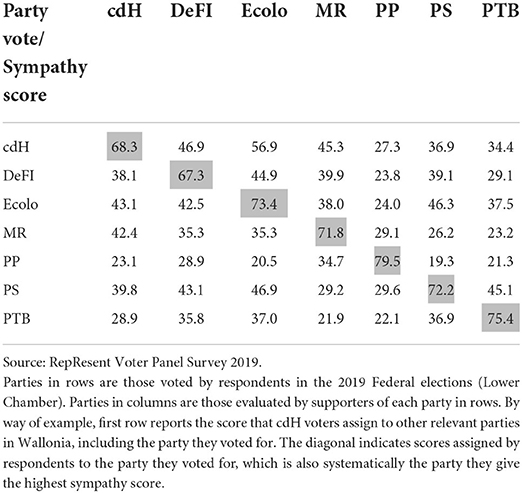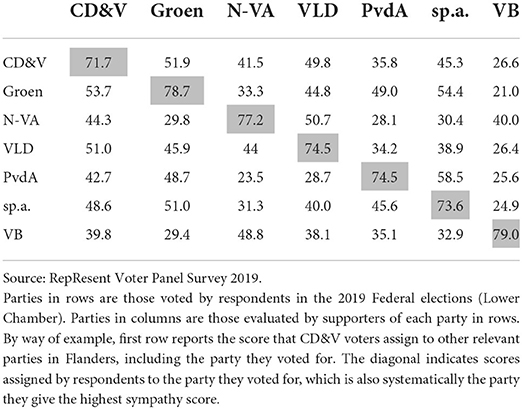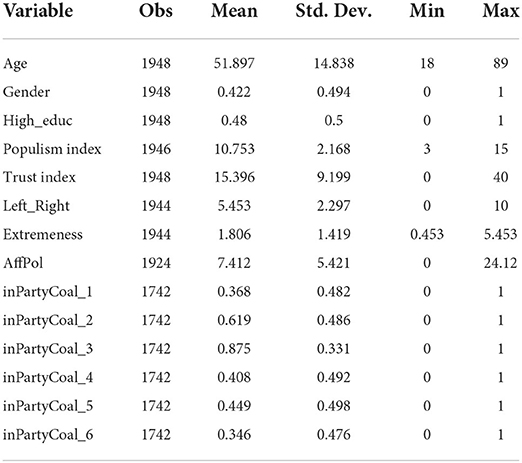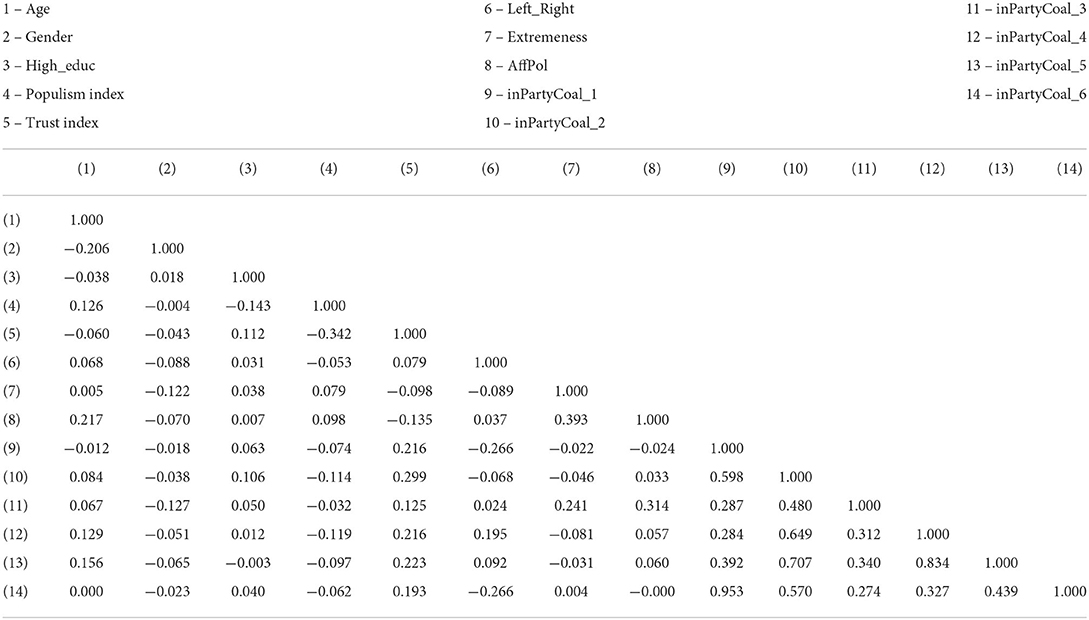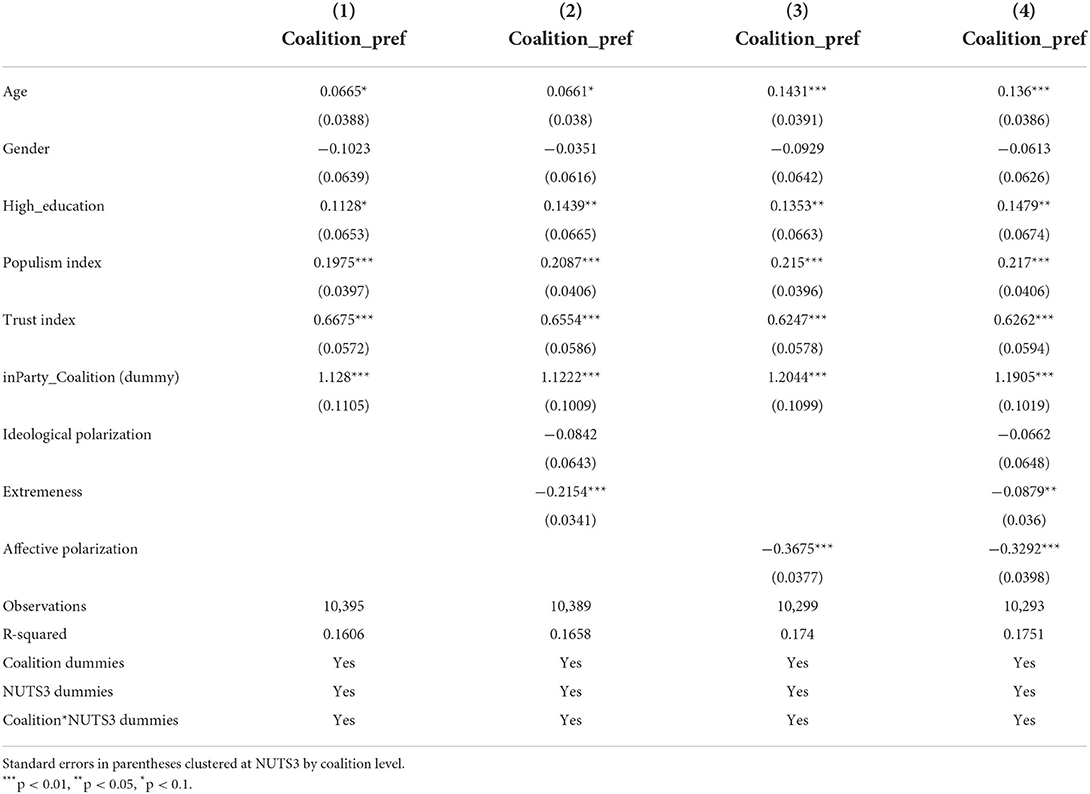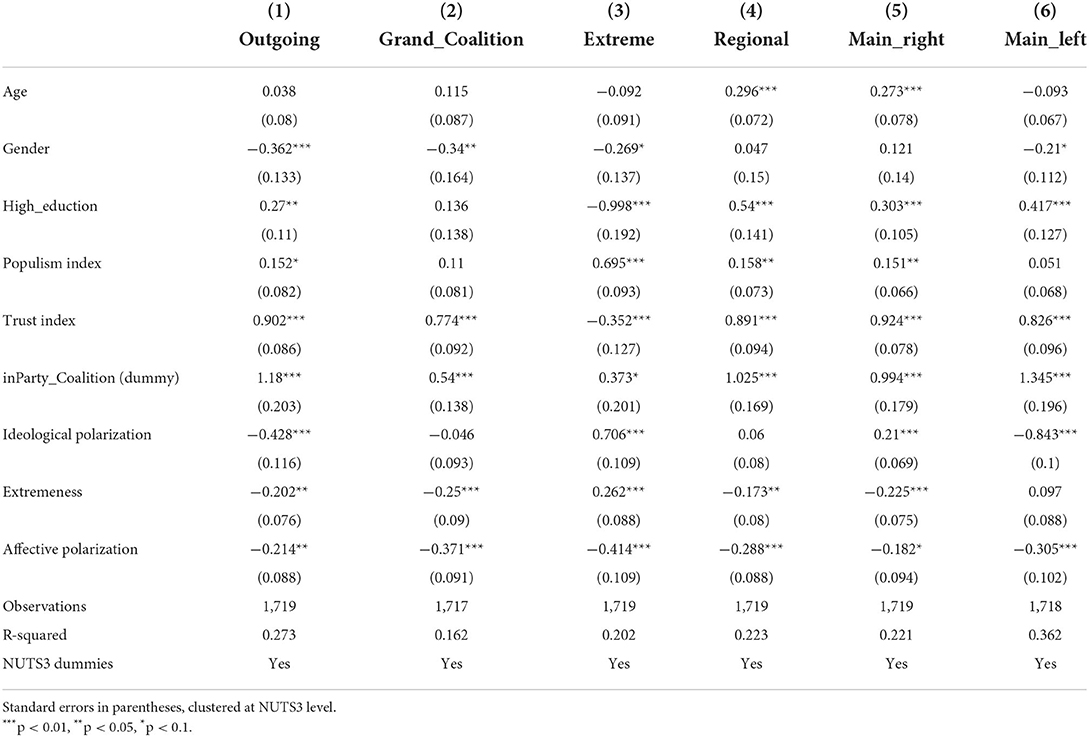- Centre d'Etude de la Vie Politique (Cevipol), Department of Political Science, Université Libre de Bruxelles, Brussels, Belgium
Using the RepResent Voter Panel Survey conducted in Belgium since the 2019 Federal elections, we investigate the relationship between affective polarization and voters' coalition preferences, in the first phase of the COVID-19 pandemic. Results confirm a strict negative link between affective polarization and preferences for coalitions in general. Such result is robust to different types of coalitions, in terms of number and size of parties, as well as the ideological position of voters. However, we also show how the negative effect of affective polarization can be moderated if the coalition includes the voter's in-party. Overall, our results help better understanding the political consequences of affective polarization in a multiparty setting.
Introduction
While coalition governments are the norm in Western Europe, voters' coalition preferences are surprisingly understudied (Debus and Müller, 2014). Moreover, we know even less about what drives these preferences. The existing literature stresses the role of ideology and broad political attitudes, as they affect voters' acceptance of political compromise (Plescia and Aichholzer, 2017; Plescia and Eberl, 2021). This paper contributes to this literature by looking at how citizens' acceptance of compromise has been affected by two major, yet opposing factors in the recent years: the COVID-19 pandemic, and increasing polarization.
On the one hand, research has shown how the COVID-19 pandemic, at least in its first phase, generated a “rally-around-the-flag” effect, i.e., “the tendency of public opinion to become more favorable toward political leaders in times of crisis” (Johansson et al., 2021), which fostered diffuse and specific political support (Cardenal et al., 2021; Louwerse et al., 2021). This could potentially have had spillover effects and generated an increased acceptance of cross-party compromise and a wider acceptance of coalitions (Jørgensen et al., 2021). On the other hand, political scientists have emphasized how polarization is rapidly spreading throughout western democracies, including multiparty systems where coalition governments are the rule. Scholars have long defined political polarization based on ideological divergences (Abramowitz and Saunders, 2008). Recently, researchers have started to define political polarization based on people's feelings toward parties and their supporters. The tendency among party supporters to view other parties and their supporters as disliked out-groups, while holding positive in-party feelings, has been labeled as affective polarization (Iyengar et al., 2012; Lelkes, 2016). Polarization—both affective and ideological—could potentially reduce voters' readiness to compromise, and thereby jeopardize support for coalition governments.
In light of this context, this paper analyses the relationship between affective and ideological polarization (our two independent variables) and voters' coalition preferences (our dependent variable), during the first phase of the COVID-19 pandemic. We conceive the COVID-19 pandemic as an exogenous shock to the system that generates a setting of least likely case for affective polarization to affect voters' coalition preferences. To the best of our knowledge, there are no studies investigating empirically if affective polarization has an impact on coalition preferences in general and on various coalition options. To do so, we use the 2019 RepResent panel voter survey, which has been carried out in Belgium since 2019. The survey is composed of multiple waves and allows us to collect data about polarization and coalition preferences in both pre- and post-pandemic periods. In so doing, we can exploit the early stage of the COVID-19 pandemic, characterized by a rally-around-the-flag dynamic, as a context that would be the least favorable to see polarization impacting voters' coalition preferences. It is especially true since Belgium was heavily hit at the early stage of the pandemic. Not only does the survey offer the best data to test our ideas, but Belgium also incarnates the understudied and complex character of polarization in multiparty settings, which has profound consequences for coalition formation.
Our analysis contributes to the literature by showing how affective polarization reduces the willingness to accept any type of coalition, even in a rally-around-the-flag context. This effect remains true regardless of the composition of coalitions. We also demonstrate that affective polarization does not operate through the same channel as ideological polarization. In fact, its effect remains robust to the inclusion of ideology-related variables. However, affective and ideological polarization interact, and ideological polarization exacerbates the effect of affective polarization when extreme parties are excluded from the coalition option. Contrarily, when coalitions include extreme parties, the impact of affective polarization on coalition preferences is stronger among the moderate voter. Finally, we show that including voters' in-party in the coalition option moderates the negative impact of affective polarization.
Voters' coalition preferences, COVID-19, and affective polarization
Coalition governments is the most frequent form of government in Western Europe (Müller and Strøm, 2003). It is therefore not surprising that the dynamics of coalition formation attracted a lot of attention from scholars. Similarly, election studies have extensively concentrated on voters' preferences for parties and candidates. Yet surprisingly, much less is known about voters' preferences for coalitions, even if it is established that voters consider coalition options when casting their vote (Blais et al., 2006; Meffert and Gschwend, 2010; Fredén, 2017), and that it is a distinct criteria from party and leader preferences (Bowler et al., 2010; Debus and Müller, 2014).
Among the few studies that investigate the determinants of voters' coalition preferences, Falcó-Gimeno (2012) and Plescia and Aichholzer (2017) show that ideological proximity is key, and that party and leader preferences also matter. In a later piece, Plescia and Eberl (2021) show that political knowledge and populist attitudes are key to understand voters' support for political compromise. It is a sign that not only ideological factors matter, but that broader attitudes toward politics are important too, as they affect capacity to accept compromises.
More recently, two different strands in the literature have dealt with factors affecting voters' capacity to accept compromises: the COVID-19 pandemic and polarization. We contend that these factors may come into play for voters' coalition preferences.
First, the burgeoning literature on the political consequences of COVID-19 has discussed rally-around-the-flag effects, especially during early stages of the pandemic characterized by strict lockdowns. Multiple studies have stressed that lockdowns in the early stages of the pandemic have increased diffuse support, i.e., voters' satisfaction with democracy and trust in government in general, and specific support, i.e., electoral support for incumbent leaders and governments (Baekgaard et al., 2020; Bol et al., 2021; Kritzinger et al., 2021). Schraff (2020) argues that these dynamics can be explained by “an emotionally driven rally effect that pushes cognitive evaluations to the background.” This rally-around-the-flag was witnessed among political elites too, with increased cross-partisan consensus (Merkley et al., 2020; Collignon et al., 2021; Jungkunz, 2021). Relatedly, we argue that this rally-around-the-flag effect can facilitate voters' acceptance of compromises, and therefore generate a context of wider acceptance for coalition governments in general.
But polarization might jeopardize that effect. On the one hand, we expect affective polarization to affect voters' acceptance of compromise, and therefore their coalition preferences. Initially introduced by Iyengar et al. (2012), affective polarization refers to the tendency among party supporters (the in-party group) to increasingly dislike or resent supporters of other parties (the out-party group). In line with this view, high levels of affective polarization imply a strong attachment to an in-party and a strong dislike of all other parties. The fast-growing literature has mainly focused on measuring, assessing, and explaining levels of affective polarization across democracies and over time (see, a.o., Lelkes, 2016; Webster and Abramowitz, 2017; Carlin and Love, 2018; Levendusky, 2018; Druckman and Levendusky, 2019; Iyengar et al., 2019; Boxell et al., 2020; Gidron et al., 2020; Reiljan, 2020; Wagner, 2021). Much less is known about the political consequences of affective polarization. Ward and Tavits (2019) demonstrated that higher levels of affective polarization create biases in perception of party competition, with voters viewing other parties as more extreme. Affective polarization is also associated to exclusivity, resistance to compromise, intolerance and rejection, and advancement of their own group over collective good (Mason, 2018; Whitt et al., 2020). At the elite level, it also reduces the incentives to cooperate and compromise and increases the risks of gridlock, especially in multiparty systems where coalition government is the rule. Following this logic, we expect that voters displaying high levels of affective polarization dislike any form of coalition. Moreover, we expect that the impact of affective polarization does not depend on coalition options, unlike ideological polarization, given that highly affectively polarized people should dislike all other parties, except their own in-party. As a results, we expect that:
H1: Affective polarization reduces voters' support for coalition in general, regardless of the type of coalition.
We test this hypothesis under what we consider as a least likely case, the first phase of the COVID-19 pandemic characterized by a rally-around-the-flag dynamic.
Of course, ideological polarization, conceived as a political orientation characterized by ideological extremeness (Plescia and Aichholzer, 2017), may moderate the rally-around-the-flag effect too (Schraff, 2020). However, as already put forward by existing literature (Reiljan and Ryan, 2021), we agree on considering affective and ideological polarization as different phenomena, and we expect the two to have distinct effects on voters' coalition preferences in general. As a result, we formulate the following hypothesis:
H2: Ideological and affective polarization have separate, direct effects on voters' coalition preferences.
Even though we recognize that affective and ideological polarization are not the same, one may expect that the two dimensions interact with each other, especially when voters consider specific coalition options. In this view, the effect of affective polarization may be either exacerbated or moderated by ideological polarization. van Erkel and Turkenburg (2022) find that affective polarization is largely rooted in ideological polarization, but that this is exacerbated for citizens holding extreme ideological views. Moreover, the ideological position of voters may also matter, as much as median voters, who are located at the center of the political spectrum, may accept that their own party collaborates with other parties more easily. Therefore, we expect the following:
H3a: Ideological polarization exacerbates the effect of affective polarization when extreme parties are excluded from coalition, as ideologically extreme voters may dislike such coalition to a great extent.
H3b: Ideological polarization moderates the effect of affective polarization when extreme parties are included in coalition, as moderate voters may dislike such coalition to a great extent.
Finally, we also recognize that the effect of affective polarization may not be homogeneous across voters. In fact, it may be counterbalanced by the fact that a voter's in-party is included in the coalition or not, as shown by Plescia and Aichholzer (2017). Therefore, we want to test if the negative impact of affective polarization on coalition preferences vanishes if the coalition includes the in-party. Theoretically, it depends on which of the two dimensions characterizing affective polarization, i.e., in- and out-party, dominates. As a result, we formulate two contrasting hypotheses:
H4a: If the in-party dimension of affective polarization dominates over the out-party one, the effect of affective polarization should reduce if the coalition includes the in-party.
H4b: If the out-party dimension of affective polarization dominates over the in-party one, the effect of affective polarization should not reduce if the coalition includes the in-party.
Materials and methods
Case selection and data
Belgium is an interesting case to study affective polarization and voters' coalition preferences, as the country has a long-standing tradition of coalition governments (Delwit and Van Haute, 2021). In fact, Belgium is a highly fragmented multiparty system. Since the split of traditional party families along the French-Dutch linguistic divide, Belgium is characterized by two party systems operating separately (Table 1): Flemish parties compete in Flanders (north of the country), whereas Francophone parties compete in Wallonia (south of the country). Note that we exclude Brussels from our analysis due to complexity (parties from the two language groups compete on its territory) and data availability.
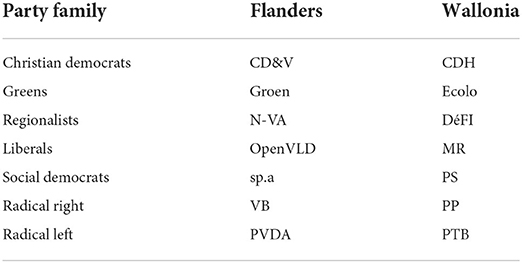
Table 1. List of parties with a representation in the federal parliament, 2014–2019 and 2019-present.
Furthermore, the relationship dynamics between parties has changed over the last decades. Belgium has long been labeled as a typical case of consociational democracy with deep social divisions mediated by consensus at the elite-level. However, the capacity of the elite of the two main linguistic groups (French- and Dutch-speakers) to reach agreements has been challenged in last years, as indicated by the length of government formation at the federal level (De Winter, 2019). This translated into polarizing trends in the ballot box (Goovaerts et al., 2020). The 2019 elections saw substantial shifts in party preferences and the rise of radical left (PVDA-PTB, 12 seats in the Lower Chamber, +10) and radical right parties (VB, who became the second party in Flanders with 18 seats in the Lower Chamber, +15) and the continuing decline of center, Christian Democratic parties (CD&V, CDH, DéFI). These trends show how Belgium incarnates the understudied and complex character of polarization in multiparty settings, which has profound consequences for coalition formation. Nevertheless, affective polarization and its consequences remain understudied in this setting (with a few exceptions, see van Erkel and Turkenburg, 2020).
Our main data source is the RepResent Panel Voter Survey 2019, conducted by the EOS consortium of five research teams at the University of Antwerp, Vrije Universiteit Brussel, KULeuven, Université libre de Bruxelles et UCLouvain. It is a rich and original dataset that includes multiple waves (more details in Pilet, 2020). In this article, we use two separate waves. Our independent variables (affective and ideological polarization) are collected using wave 2. It is a post-electoral wave, conducted between May and June 2019, where a total of 3,824 individuals have been interviewed. Our dependent variable (voters' coalition preferences) is drawn from wave 3, where 1,675 individuals have been interviewed on April 2020. The time elapsed between the waves reassures us against potential endogeneity issues.1 Moreover, we collect affective polarization data before COVID-19 pandemic, to make sure that its measure is not affected by the pandemic context. Conversely, coalition options proposed to survey respondents are post-elections (after results are announced), as voters may adjust their preferences to election outcomes, but during early-stages of the COVID-19 pandemic. Indeed, the first COVID case was reported in Belgium in February 2020. On 10 March, the first COVID-19 related death was reported. Belgium was ranked among the countries with the highest COVID-19 mortality in the world during its first COVID-19 wave, which occurred in March-April 2020 (Vandael et al., 2022). The COVID-19 pandemic is therefore used as general context that provides the toughest setting to test the relationship between affective polarization and coalition preferences, as it is recognized by the literature that the rally-around-the-flag effect is particularly relevant during the first phases of crisis. In doing so, we conceive the COVID-19 pandemic as an exogeneous shock to the system that generates a setting of least likely case for affective polarization to affect voters' coalition preferences. Should we find an effect of affective polarization on coalition preferences, it would support our argument despite strong contextual variables favoring acceptance of compromise.
The survey was conducted using CAWI questionnaires (Computer Assisted Web Interviewing) and was distributed by Kantar TNS to their own online panel. Panel participants were selected using a quota sample based on gender, age, education, and region of residency. The final samples slightly differ from the target population, with an overrepresentation of higher educated respondents and age group 45–65. Therefore, in the empirical analysis when running regressions we use weights for age, gender, education, as well as vote share.
Operationalization of the variables
To grasp our dependent variable, i.e., respondents' coalition preference, we make use of the following question from the RepResent survey: “As part of the negotiations to form a government in the context of the coronavirus crisis, various coalition options were considered. Can you tell us for each of the following options whether you would have approved it or not?.” Respondents were asked to express their preferences on a scale 0–10, the higher the better. The Survey offered six coalition options, each of them including different parties (see Table 2). According to the structure of each coalition, we define them: (i) outgoing, including parties from previous minority right-wing government; (ii) grand coalition, composed of all left- and right-wing mainstream parties; (iii) extreme, which includes all parties including the Flemish radical right party (VB) and the radical left party (PTB-PVDA); (iv) regional, including mainstream parties and regionalist parties; (v) mainstream right, including mainstream parties with an average right-wing orientation; (vi) mainstream left, including mainstream parties with an average left-wing orientation. The availability of a widespread range of coalitions, varying in terms of number of parties and ideological orientation, allows us to investigate, beyond the overall relationship between affective polarization and coalition preferences, the extent to which such preferences depend on the set of available parties.
To measure our main independent variable, the individual-level degree of affective polarization, we use thermometer ratings, the most common strategy in the literature (Iyengar et al., 2019). We make use of the following question from the RepResent dataset: “Could you use the scale [0–100] to indicate how you feel about the following groups?.” According to the distinct party offer, respondents in Flanders had to indicate their feelings toward supporters of 7 Dutch-speaking, and respondents in Wallonia had to indicate their feelings toward supporters of 7 French-speaking parties (see Table 1). The higher the score, the higher the sympathy toward partisans of the party. To identify the respondent's favorite party (in-group) among available parties, we use respondents' self-reported vote choice for the Lower Chamber in the 2019 federal elections, reported in wave 2. The exact question wording was: “For which party did you vote for the Chamber during the national elections on the 26th of May 2019?”. The answer categories correspond to the party offer listed in alphabetical order, in Flanders (7 parties) and Wallonia (7 parties) respectively. Respondents who chose “Other,” “Blank or Invalid,” “I did not vote,” “I was not (yet) eligible to vote,” or “I do not remember” were excluded from our analysis. In a proportional representation system, the proportion of wasted votes is relatively low, and voters are expected to vote according to their actual preference rather than strategic considerations (Cox, 1997). Our data confirms that voters in Flanders and Wallonia systematically give the highest sympathy score to partisans from the party they voted for (see Tables 3, 4).
To compute the affective polarization index, we follow Reiljan's (2020) approach that is adapted to multiparty settings. This index allows us to adopt a more parsimonious empirical strategy, as it drops observations in case of voters that do not identify with a specific in-party. Moreover, it takes into account the size of each party, under the idea that small or big parties should be weighted differently. Accordingly, we use the actual vote share in 2019 Federal elections as a measure of the relevance of each party.
The affective polarization index is computed based on the following equation:
where i indicates a survey respondent, n the in-party, m the out-parties and N the total number of relevant parties. The denominator (1−Vote Sharen) is intended to exclude the in-party share of votes from this part of the calculation. In this way, the combined vote share of the out-parties would equal 100. Since we expect (Scoren−Scorem) being positive or equal to zero, as people should evaluate the in-party at least as good as each out-party, the affective polarization index Affpoli ∈ [0, 100]. Tables 3, 4 confirm this conjecture: diagonals in both matrices, indicating the average score that respondents assign to their favorite party, report values that are far higher than those in other cells, which report the out-group scores. Note that, as we weight our measure of affective polarization for the size of both in- and out-parties in terms of electoral results, with wieghts ∈ (0, 1), the resulting index is by contruction <100.
Following Plescia and Aichholzer (2017), we measure the ideological orientation of respondents, making use of two variables. First, we include in our analysis the standard self-reported left-right orientation of respondents, defined on a 0–10 scale, where 0 identifies left-oriented people and 10 right-oriented ones. Then, we account for the degree of ideological extremeness of respondents, computed as the absolute difference between respondents' own score on the left-right scale and the average score across our population. The higher the variable, the more extreme is the respondent. These two variables allow us to further establish that affective polarization and ideological polarization are two distinct phenomena.
As controls, we include standard individual-level socio-demographic variables (gender, age, education) as they were shown relevant for coalition preferences (Plescia and Eberl, 2021), where gender is a dummy equal to one for females, age is a continuous variable, while High_education is a dummy equal to one if respondents have the ‘university degree'. We also include an index measuring the degree of populism of respondents, as it has been shown to affect coalition preferences (Plescia and Eberl, 2021), as well as protest attitudes and behaviors in Belgium (Goovaerts et al., 2020). To do it, we create an additive index the sums up over three items: “Politicians must follow the people's opinion”; “Political opposition is more present between citizens and the elite than between citizens themselves”; “I prefer being represented by an ordinary citizen rather than by a professional politician” (α = 0.83). Respondents express their preferences using a scale 1–5, such that our populism index ranges from 3 to 15, with a mean of 10.8, the higher the index the stronger the degree of populism. To control for the rally-around-the-flag effect, an index of trust in political institutions is also included in the analysis. Again, we assemble an additive index that accounts for the level of trust of each respondent with respect to political parties, federal parliament, politicians, and the European union, on a scale 0–10 (α = 0.81). The resulting trust index ranges from 0 to 40, the higher the index the more the respondents trust in political institutions. We expect high values of the index to be associated with positive preferences toward coalition in general, regardless of the structure of the coalition itself.
We also include in our model a battery of NUTS-3 dummies, based on information about the place of residence of the respondents. This allows us to estimate a more robust econometric model, as we take into account that the place of residence may have an effect on political preferences in general and, as a result, on preferences over coalitions. By way of example, support for extreme/populist parties (and coalitions including these parties) is not randomly distributed across a national territory, but is clustered in specific areas, e.g., inner areas (Dijkstra et al., 2020) or economically declining regions (Rodriguez-Pose, 2020). As a result, there may exist patterns of preferences over specific coalitions associated with the territory of residence.
Finally, we take into account that feelings for parties matter in shaping coalition preferences (Meffert and Gschwend, 2010). In this view, a voter's preferences over coalition may strongly depend on the presence in the coalition of the party they feel the closest to Plescia and Aichholzer (2017). Thus, we create a dummy variable equal to one if the coalition includes the in-party of the respondent.
Tables 5, 6 report descriptive statistics and correlation matrix, respectively. The latter indicates that we do not suffer from collinearity issues among independent variables, as we observe high correlation only among inParty_Coal dummies that never enter simultaneously our regressions.
Modeling strategy
We run different regressions depending on the research objectives, i.e., (1) analyzing the relationship between affective polarization and preference for coalition governments in general, and (2) for specific types of coalition governments.
To meet our first goal, we must deal with a source of heterogeneity that may interfere in the relationship between affective polarization and coalition offer in general, i.e., the composition of the coalition offer. To solve this problem, we reshape the dataset in long form such that the unit of analysis is no longer the survey respondents but responses, i.e., the dyad respondent-coalition preference. As we have six coalitions offer in our survey, each respondent enters the dataset six times. In so doing, by controlling for coalition fixed effect, we can establish a more clear-cut relationship between affective polarization and coalition preferences in general, as we account for the type of coalition offer. As a result, we estimate the following regression:
where subscripts i and c indicate survey respondent and coalition, respectively. Vector X includes the set of controls presented in section operationalization of the variables, Ideo refers to the two variables related to political ideology and AffPol is the affective polarization index. Note that, equation (1) also includes NUTS-3 and coalition fixed effect, as well as the interaction among the two, as residents from Flanders may have different patterns of preferences over specific coalition compared to residents from Wallonia, e.g., due to the strength of the regionalist movement in Flanders. The error term is clustered at coalition by territory level.
Then, we aim at investigating the extent to which the relationship between affective polarization and preferences over coalition depends on the type of the coalition offer. Thus, we run separate regressions where the dependent variable indicates preferences over each coalition, separately.
Here, Equation (1) collapses to:
with c ∈ [1, 6]. Note that in equation (2) the set of fixed effect reduces to NUTS3 regions, and the error term is clustered at the territorial level.
Finally, to investigate the combined effect of affective and ideological polarization, as well as the potential moderating effect of coalitions including in-party, we augment equations (2) with interactions terms involving the variables of interest, namely affective polarization, ideological extremeness and the inParty_Coal dummy.
Note that in the empirical analysis we standardize continuous variables using the z-score (mean equal to zero, standard deviation equal to one), to ease comparison among variables computed at different scale.
Results
First, we analyze the relationship between affective polarization and preference for coalition governments in general. In Table 7, we present results from a set of regressions based on equation (1). As we control for coalition fixed effects, our results should be interpreted as preferences over coalition governments in general, regardless of the composition of coalitions. We first check the behavior of our set of controls (column 1). As far as socio-demographic variables are concerned, their effect on coalition preference is weak, as indicated by size and significance level of coefficients. In detail, age and education are positively correlated with coalition preferences. This indicates that older respondents with higher levels of education are, in general, more in favor of coalition governments than younger respondents with lower levels of education. On the other side, the coefficient associated with gender of respondents is not statistically different from zero, thus signaling that there are no systematic gender-related differences in driving preferences over coalition. The effect of political variables is much stronger. Both populism and trust indices show large and significant coefficients, even though the latter is two times as large as the former. This shows that trust in political institutions is associated with higher preferences for coalition governments in general. As expected, the dummy indicating if the coalition includes respondent's in-party is positive, large in magnitude, and highly statistically significant.
In column 2, we switch the focus on our ideological variables, i.e., left-right orientation and degree of extremeness. Only extremeness shows a significant coefficient, with a negative sign. This means that individuals that are located at the extremes of the political spectrum (left and right), dislike coalition governments more than moderate individuals. In columns (3–4), we include the affective polarization index, with and without ideological variables. The variable enters with negative sign in both instances, thus indicating that higher levels of affective polarization decrease the support for coalition governments, and this does not dependent on the type of coalition. It means that a stronger dislike of political opponents (whatever their ideological orientation) drives citizens to be more intolerant and increasingly reject compromises in the form of coalition governments. This result supports H1. This is a further evidence of the negative political consequences of affective polarization in a multiparty setting (Mason, 2018). Results in column 4 also support the hypothesis of an independent effect of affective and ideological polarization, as the coefficient of affective polarization does not significantly vary from column 3 to 4 (H2 supported).
Three aspects are noteworthy at this stage. First, as we control for coalition fixed effects, our results should be interpreted as preferences over coalition in general, regardless of the composition of coalition. Second, the fact that coefficient associated with ideological extremeness partially drops when included simultaneously with the affective polarization index may signal that the two phenomena potentially interact with each other. Accordingly, affective polarization may capture the effect of ideological extremeness, since the former may mainly impact on coalition preferences through preferences of extreme people. Thirdly, in Table 7 we control for the effect of having the in-party in coalition, since we aim to isolate the relationship between affective polarization and coalition preferences. However, it does not exclude that the impact of affective polarization may vanish when respondents' in-party is included in the coalition. Thus, we extend our baseline analysis to address the above aspects.
First, we run different regressions where the dependent variables are the six coalition options, considered separately (as in equation 2). Results in Table 8 broadly follow expectations. If we disentangle the effect of our control variables on the various types of coalitions, we obtain a more nuanced view than the one provided in Table 7. Education is positively linked to most coalition types except the extreme one, where the coefficient is negative and significant (column 3). The same applies to Trust. The variable inParty_Coal too keeps sustaining preference for specific coalition types, even though its effect drastically drops (both in terms of size of coefficient and significance level) in column 3. This may be due to moderate voters, who are reluctant to support a coalition including extreme parties even if their in-party is included. As far as the populism index is concerned, we can note that the effect that we found in Table 7 is mostly driven by preference of populist voters for the extreme coalition (column 3). If we consider our main independent variables, ideological and affective polarization, we see that the left-right orientation supports our expectations, as it enters with a negative and significant coefficient when the coalition includes left-oriented parties, and viceversa in case of right-wing ones. Interestingly, its coefficient is positive, large in magnitude and highly statistically significant when respondents are asked to evaluate the coalition that includes extreme parties, thus indicating that the opinion of supporters of extreme right-wing parties predominates. When it comes to ideological extremeness, coefficients are negatively associated with most coalition options except the extreme one. Finally, high level of affective polarization is negatively associated with all types of coalition, regardless of its composition. This powerful result further corroborates H1. In fact, the affective polarization index is the only independent variable that behaves consistently across all coalition offers and always enters with negative sign. Moreover, it may indicate that the effect of affective polarization is not linked to specific parties, neither to extreme ideology; contrarily, it operates both from extreme voters to moderate ones, as well as the other way round.
To check the validity of the latter claim, we augment equation (2) with interaction terms involving affective polarization and ideological extremeness. Graphs in Figure 1 report average marginal effects. Results corroborate our hypothesis 3. Affective polarization significantly interacts with ideological extremeness, but the combined effect changes depending on the type of coalition. It is stronger among extreme people in coalitions excluding extreme parties (H3a supported), but weaker for the coalition that includes extreme parties, where affective polarization turns out to be stronger among moderate people (H3b supported). Overall, Figure 1 further corroborates that affective polarization significantly reduces support for coalitions, regardless of the coalition offer.
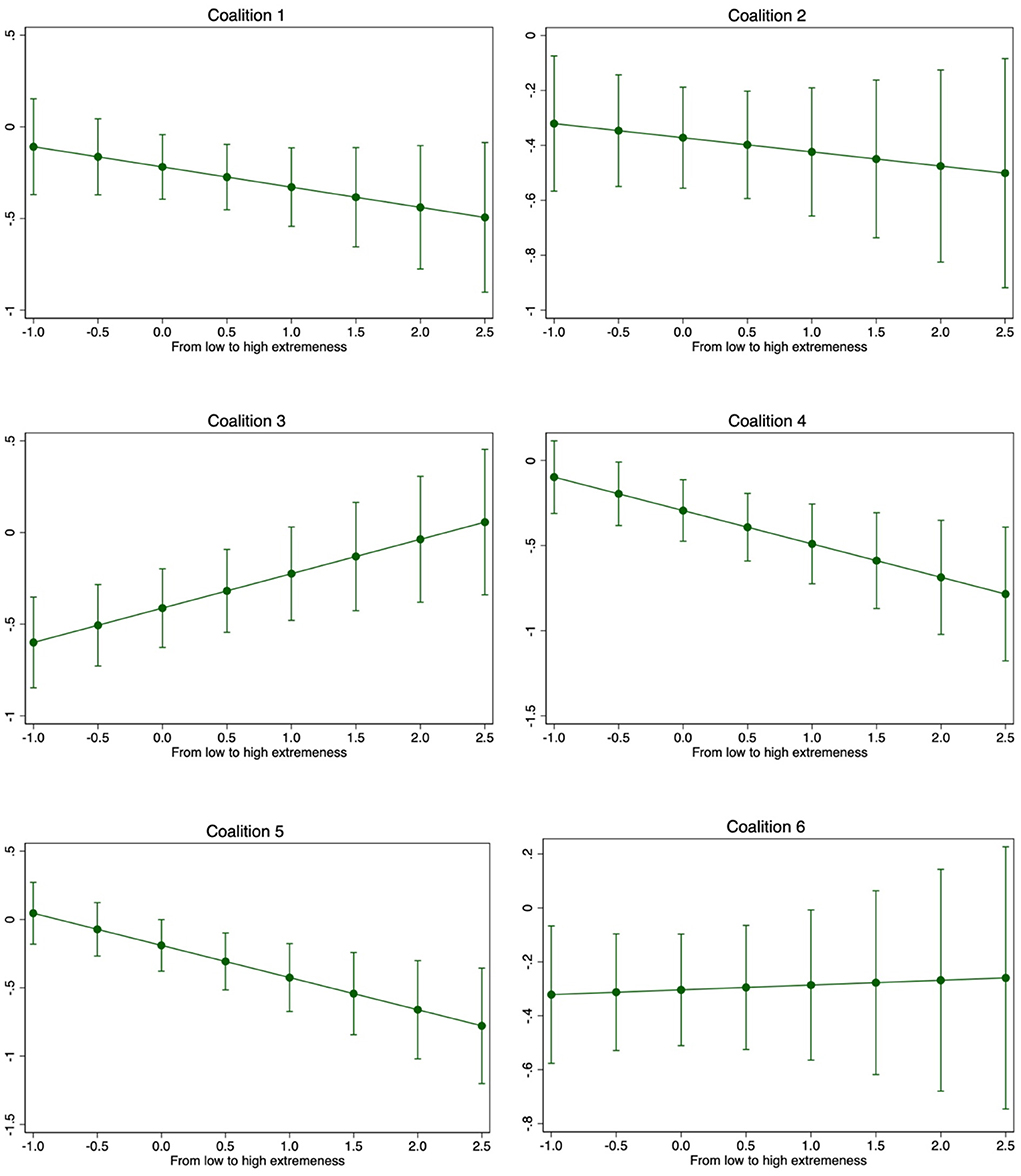
Figure 1. Interactions between affective polarization and ideological extremeness. Coalitions number are: 1-Outgoing; 2-Grand Coalition; 3-Extreme; 4-Regional; 5-Mainstream right; 6-Mainstream left.
That said, is there a way to reduce the negative impact of affective polarization on coalition preferences? Since affective polarization increases with the attachment to in-party, it may be that having the in-party as part of the coalition government relaxes the impact of affective polarization. In baseline regressions, we controlled for a dummy equal to one if coalitions include respondent's in-party. Hereafter, we interact such dummy with the affective polarization index. Table 9 reports average marginal effects of the affective polarization index, when the in-party is either out of the coalition type or in the coalition type. Differently said, this exercise signals whether the in-party dimension of affective polarization dominates over the out-party one, or viceversa. Broadly, we find support for the idea that having the in-party in coalition nullifies the effect of affective polarization (H4a supported), with few exceptions (see columns 2 and 3). In particular, the counter-intuitive result in col. 3 may depend on the opinion of moderate voters, who dislike having their in-party that shares the stage with extreme parties.
Conclusion
This paper has sought to unpack the drivers of voters' preferences for coalitions in general, and for specific coalition types. Using Belgium as a case study and the 2019 RepResent panel voter survey, we investigated the impact of affective and ideological polarization on voters' coalition preferences, in the first phase of the COVID-19 pandemic. The Belgian context was least favorable to see polarization impact voters' coalition preferences, as Belgium was heavily hit at the early stage of the pandemic. Therefore, we argue that our results should hold in other, more favorable contexts. Yet further research should establish if it is the case.
Overall, our analysis contributes to the literature on the effects of the COVID-19 pandemic, voters' coalition preferences, and the growing literature on affective polarization. Our analysis brings three main contributions. First, we show that the effects of affective polarization on voters' preferences for coalitions is very strong. It is visible even in the least likely context, such as the early stages of the COVID-19 pandemic characterized by a rally-around-the-flag effect. This is an important finding for decision-makers in times of crises, especially in countries characterized by high levels of affective polarization when a crisis occurs. Second, we provide novel insights to the literature investigating coalition preferences by showing that affective polarization decreases support for coalition governments in general. This effect remains true regardless of the composition of coalitions, thus signaling that affective polarization is not only associated with extreme voters. Third, we extend the growing body of literature on affective polarization by switching the focus from the analysis of its drivers, as most of the literature does, to the consequences of affective polarization. In this regard, our results contribute to the literature on the negative consequences of affective polarization. We show that high levels of affective polarization among voters implies a rejection of inter-party cooperation in the form of coalitions. We also demonstrate that affective polarization does not operate through the same channel as ideological polarization. In fact, its effect remains robust to the inclusion of ideology-related variables. However, affective and ideological polarization are related, as ideological polarization exacerbates the effect of affective polarization when extreme parties are excluded from the coalition option. Finally, we show that including voters' in-party in the coalition option moderates the negative impact of affective polarization.
Taken together, these results contribute to the debate on the link between affective and ideological polarization of voters, and elites' response. Bassan-Nygate and Weiss (2022) have shown how inter-party cooperation can depolarize the electorate. Huddy and Yair (2021) show how warm social relations between opposing elites can reduce affective polarization, while policy compromise does not. Some form of elite cooperation is therefore needed in multiparty systems to reduce polarization and its negative effects. However, we show that the relation goes both ways, and that high levels of affective polarization among the electorate makes voters less ready to accept compromises. If party elites follow this signal, it may undermine their willingness to cooperate and jeopardize the functioning of multiparty systems, bound to function via coalition governments. These negative consequences are reinforced by ideological polarization if extreme parties are excluded from government. This signals that elite cooperation may not be enough if limited to mainstream parties in a context of high levels of polarization. More research is therefore needed to disentangle this relationship and to better understand under which conditions elite cooperation can counterbalance the negative effect that affective polarization exerts on coalition preferences. Beyond the nature of the cooperation (power sharing, policy compromise, or social relations), which elites cooperate may be a crucial factor.
Data availability statement
Publicly available datasets were analyzed in this study. This data can be found here: https://represent-project.be/data/.
Author contributions
Both authors listed have made a substantial, direct, and intellectual contribution to the work and approved it for publication.
Funding
This manuscript benefited from the funding from the European Union's Horizon 2020 research and innovation programme under the Marie Skłodowska-Curie grant agreement No. 801505 and FWO-FNRS EoS N°30431006 for the research project RepResent.
Conflict of interest
The authors declare that the research was conducted in the absence of any commercial or financial relationships that could be construed as a potential conflict of interest.
Publisher's note
All claims expressed in this article are solely those of the authors and do not necessarily represent those of their affiliated organizations, or those of the publisher, the editors and the reviewers. Any product that may be evaluated in this article, or claim that may be made by its manufacturer, is not guaranteed or endorsed by the publisher.
Footnotes
1. ^See the project website to download data/codebook: https://represent-project.be.
References
Abramowitz, A. I., and Saunders, K. L. (2008). Is polarization a myth?. J. Polit. 70, 542–555. doi: 10.1017/S0022381608080493
Baekgaard, M., Christensen, J., Madsen, J. K., and Mikkelsen, K. S. (2020). Rallying around the flag in times of Covid-19: Societal lockdown and trust in democratic institutions. J. Behav. Public Admin. 3, 1–12. doi: 10.30636/jbpa.32.172
Bassan-Nygate, L., and Weiss, C. M. (2022). Party competition and cooperation shape affective polarization: evidence from natural and survey experiments in Israel. Comp. Polit. Stud. 55, 287–318. doi: 10.1177/00104140211024283
Blais, A., Aldrich, J. H., Indridason, I. H., and Levine, R. (2006). Do voters vote for government coalitions?: Testing downs' pessimistic conclusion. Party Polit. 12, 691–705. doi: 10.1177/1354068806068594
Bol, D., Giani, M., Blais, A., and Loewen, P. J. (2021). The effect of COVID-19 lockdowns on political support: some good news for democracy? Eur. J. Polit. Res. 60, 497–505. doi: 10.1111/1475-6765.12401
Bowler, S., Karp, J. A., and Donovan, T. (2010). Strategic coalition voting: evidence from New Zealand. Elect. Stud. 29, 350–357. doi: 10.1016/j.electstud.2010.03.001
Boxell, L., Gentzkow, M., and Shapiro, J. M. (2020). Cross-country trends in affective polarization. Natl. Bur. Econ. Res. doi: 10.3386/w26669
Cardenal, A. S., Castro, L., Schemer, C., Strömbäck, J., Ste, A., de Vreese, C., et al. (2021). “Divided we trust?: the role of polarization on rally-around-the-flag effects during the COVID-19 crisis,” in Political Communication in the Time of Coronavirus (Routledge), 157–173. doi: 10.4324/9781003170051-13
Carlin, R. E., and Love, G. J. (2018). Political competition, partisanship and interpersonal trust in electoral democracies. Br. J. Polit. Sci. 48, 115–139. doi: 10.1017/S0007123415000526
Collignon, S., Makropoulos, I., and Rudig, W. (2021). Consensus secured? Elite and public attitudes to “lockdown” measures to combat COVID-19 in England. J. Elections Public Opin. Parties 31, 109–121. doi: 10.1080/17457289.2021.1924750
Cox, G. W. (1997). Making Votes Count: Strategic Coordination in the World's Electoral Systems. Cambridge: Cambridge University Press.
De Winter, L. (2019). “Government coalitions as a reflection of national politics: The complex case of Belgium,” in Coalition Government as a Reflection of a Nation's Politics and Society, ed M. Evans (London: Routledge).
Debus, M., and Müller, J. (2014). Expected utility or learned familiarity? The formation of voters' coalition preferences. Electoral Stud. 34, 54–67. doi: 10.1016/j.electstud.2013.09.007
Delwit, P., and Van Haute, É. (2021). Les partis politiques en Belgique (4th Edn.). Éditions de l'Université de Bruxelles.
Dijkstra, L., Peolman, H., and Rodriguez-Pose, A. (2020). The geography of EU discontent. Reg. Stud. 54, 737–753. doi: 10.1080/00343404.2019.1654603
Druckman, J. N., and Levendusky, M. S. (2019). What do we measure when we measure affective polarization. Public Opin. Q. 83, 114–122. doi: 10.1093/poq/nfz003
Falcó-Gimeno, A. (2012). Preferences for political coalitions in Spain. South Eur. Soc. Polit. 17, 487–502. doi: 10.1080/13608746.2012.701900
Fredén, A. (2017). Opinion polls, coalition signals and strategic voting: evidence from a survey experiment. Scan. Polit. Stud. 40, 247–264. doi: 10.1111/1467-9477.12087
Gidron, N., Adams, J., and Horne, W. (2020). American Affective Polarization in Comparative Perspective. Cambridge: Cambridge University Press. doi: 10.1017/9781108914123
Goovaerts, I., Kern, A., Van Haute, E., and Marien, S. (2020). Drivers of support for the populist radical left and populist radical right in belgium: an analysis of the VB and the PVDA-PTB vote at the 2019 elections. Politi. Low Ctries. 2, 228–264. doi: 10.5553/PLC/258999292020002003002
Huddy, L., and Yair, O. (2021). Reducing affective polarization: warm group relations or policy compromise?. Polit. Psychol. 42, 291–309. doi: 10.1111/pops.12699
Iyengar, S., Lelkes, Y., Levendusky, M. S., Malhotra, N., and Westwood, S. J. (2019). The origins and consequences of affective polarization in the United States. Annu. Rev. Polit. Sci. 22, 129–146. doi: 10.1146/annurev-polisci-051117-073034
Iyengar, S., Sood, G., and Lelkes, Y. (2012). Affect, not ideology a social identity perspective on polarization. Public Opin. Q. 76, 405–431. doi: 10.1093/poq/nfs038
Johansson, B., Hopmann, D. N., and Shehata, A. (2021). When the rally-around-the-flag effect disappears, or: when the COVID-19 pandemic becomes “normalized”. J. Elections Public Opin. Parties 31, 321–334. doi: 10.1080/17457289.2021.1924742
Jørgensen, F., Bor, A., Lindholt, M. F., and Petersen, M. B. (2021). Public support for government responses against COVID-19: assessing levels and predictors in eight Western democracies during 2020. West. Eur. Polit. 44, 1129–1158. doi: 10.1080/01402382.2021.1925821
Jungkunz, S. (2021). Political polarization during the COVID-19 pandemic. Front. Polit. Sci. 3:622512. doi: 10.3389/fpos.2021.622512
Kritzinger, S., Foucault, M., Lachat, R., Romain, L., Partheymüller, J., Plescia, C., et al. (2021). Rally round the flag': The COVID-19 crisis and trust in the national government. West Eur. Polit. 44, 1205–1231. doi: 10.1080/01402382.2021.1925017
Lelkes, Y. (2016). Mass polarization: manifestations and measurements. Public Opin. Q. 80, 392–410. doi: 10.1093/poq/nfw005
Levendusky, M. S. (2018). Americans, not partisans: can priming American national identity reduce affective polarization? J. Polit. 80, 59–70. doi: 10.1086/693987
Louwerse, T., Sieberer, U., Tuttnauer, O., and Andeweg, R. B. (2021). Opposition in times of crisis: COVID-19 in parliamentary debates. West. Eur. Polit. 44, 1025–1051. doi: 10.1080/01402382.2021.1886519
Mason, L. (2018). Uncivil Agreement: How Politics Became Our Identity. Chicago, IL: University of Chicago Press.
Meffert, M. F., and Gschwend, T. (2010). Strategic coalition voting: evidence from Austria. Elect. Stud. 29, 339–349. doi: 10.1016/j.electstud.2010.03.005
Merkley, E., Bridgman, A., Loewen, P. J., Owen, T., Ruths, D., and Zhilin, O. (2020). A rare moment of cross-partisan consensus: elite and public response to the COVID-19 pandemic in Canada. Can. J. Polit. Sci. 53, 311–318. doi: 10.1017/S0008423920000311
Müller, W. C., and Strøm, K. (2003). Coalition Governments in Western Europe. Oxford: Oxford University Press.
Pilet, J.-B. (2020). Les Belges haussent leur voix: Une analyse des comportements électoraux du 26 mai 2019. Presses Universitaires de Louvain.
Plescia, C., and Aichholzer, J. (2017). On the nature of voters' coalition preferences. J. Elections Public Opin. Parties 27, 254–273. doi: 10.1080/17457289.2016.1270286
Plescia, C., and Eberl, J.-M. (2021). ‘Not my government!' The role of norms and populist attitudes on voter preferences for government formation after the election. Party Polit. 27, 103–113. doi: 10.1177/1354068819827513
Reiljan, A. (2020). ‘Fear and loathing across party lines' (also) in Europe: affective polarisation in European party systems. Eur. J. Polit. Res. 59, 376–396. doi: 10.1111/1475-6765.12351
Reiljan, A., and Ryan, A. (2021). Ideological tripolarization, partisan tribalism and institutional trust: the foundations of affective polarization in the Swedish multiparty system. Scand. Polit. Stud. 44, 651–663. doi: 10.1111/1467-9477.12194
Rodriguez-Pose, A. (2020). The rise of populism and the revenge of places that don't matter. LSE Public Policy Rev. 1, 4. doi: 10.31389/lseppr.4
Schraff, D. (2020). Political trust during the COVID-19 pandemic: rally around the flag or lockdown effects? Eur. J. Polit. Res. 60, 1007–1017. doi: 10.1111/1475-6765.12425
van Erkel, P., and Turkenburg, E. (2020). “Attitudes différentes, comportements électoraux différents, sentiments différents?, ≫ in Les Belges haussent leur voix (Presses universitaires de Louvain), 153–173.
van Erkel, P., and Turkenburg, E. (2022). Delving into the divide: how ideological differences fuel out-party hostility in a multiparty context. Eur. Polit. Sci. Rev. 14, 386–402. doi: 10.1017/S1755773922000121
Vandael, E., Latour, K., Islamaj, E., Panis, L. I., Callies, M., Haarhuis, F., et al. (2022). COVID-19 cases, hospitalizations and deaths in Belgian nursing homes: results of a surveillance conducted between April and December 2020. Arch. Public Health 80:45. doi: 10.1186/s13690-022-00794-6
Wagner, M. (2021). Affective polarization in multiparty systems. Elect. Stud. 69:102199. doi: 10.1016/j.electstud.2020.102199
Ward, D., and Tavits, M. (2019). How partisan affect shapes citizens' perception of the political world. Elect. Stud. 60:102045. doi: 10.1016/j.electstud.2019.04.009
Webster, S. W., and Abramowitz, A. I. (2017). The ideological foundations of affective polarization in the U.S. Electorate. Am. Polit. Res. 45, 621–647. doi: 10.1177/1532673X17703132
Keywords: affective polarization, COVID-19, Belgium, coalition government, ideological polarization
Citation: Bettarelli L and Van Haute E (2022) Affective polarization and coalition preferences in times of pandemic. Front. Polit. Sci. 4:945161. doi: 10.3389/fpos.2022.945161
Received: 16 May 2022; Accepted: 19 July 2022;
Published: 12 August 2022.
Edited by:
Lisa Zanotti, Diego Portales University, ChileReviewed by:
Sorina Soare, University of Florence, ItalyMarkus Wagner, University of Vienna, Austria
Sebastián Umpierrez De Reguero, European University Institute (EUI), Italy
Copyright © 2022 Bettarelli and Van Haute. This is an open-access article distributed under the terms of the Creative Commons Attribution License (CC BY). The use, distribution or reproduction in other forums is permitted, provided the original author(s) and the copyright owner(s) are credited and that the original publication in this journal is cited, in accordance with accepted academic practice. No use, distribution or reproduction is permitted which does not comply with these terms.
*Correspondence: Luca Bettarelli, bHVjYS5iZXR0YXJlbGxpQHVsYi5iZQ==
†These authors have contributed equally to this work
 Luca Bettarelli
Luca Bettarelli Emilie Van Haute
Emilie Van Haute